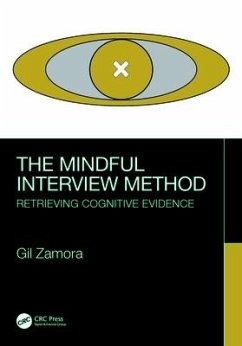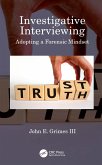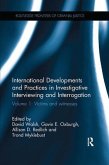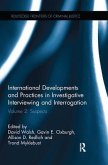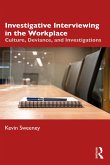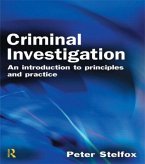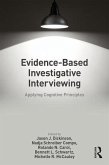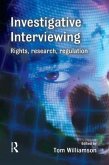- Broschiertes Buch
- Merkliste
- Auf die Merkliste
- Bewerten Bewerten
- Teilen
- Produkt teilen
- Produkterinnerung
- Produkterinnerung
This book assists investigators in gathering authentic, reliable information from eyewitnesses to identify the culprit, and improving the gathering of reliable information from private sector interviewers.
Andere Kunden interessierten sich auch für
![Investigative Interviewing Investigative Interviewing]() John E. Grimes IIIInvestigative Interviewing81,99 €
John E. Grimes IIIInvestigative Interviewing81,99 €![International Developments and Practices in Investigative Interviewing and Interrogation International Developments and Practices in Investigative Interviewing and Interrogation]() International Developments and Practices in Investigative Interviewing and Interrogation49,99 €
International Developments and Practices in Investigative Interviewing and Interrogation49,99 €![International Developments and Practices in Investigative Interviewing and Interrogation International Developments and Practices in Investigative Interviewing and Interrogation]() International Developments and Practices in Investigative Interviewing and Interrogation53,99 €
International Developments and Practices in Investigative Interviewing and Interrogation53,99 €![Investigative Interviewing in the Workplace Investigative Interviewing in the Workplace]() Kevin SweeneyInvestigative Interviewing in the Workplace51,99 €
Kevin SweeneyInvestigative Interviewing in the Workplace51,99 €![Criminal Investigation Criminal Investigation]() Peter StelfoxCriminal Investigation58,99 €
Peter StelfoxCriminal Investigation58,99 €![Evidence-based Investigative Interviewing Evidence-based Investigative Interviewing]() Evidence-based Investigative Interviewing48,99 €
Evidence-based Investigative Interviewing48,99 €![Investigative Interviewing Investigative Interviewing]() Investigative Interviewing63,99 €
Investigative Interviewing63,99 €-
-
-
This book assists investigators in gathering authentic, reliable information from eyewitnesses to identify the culprit, and improving the gathering of reliable information from private sector interviewers.
Produktdetails
- Produktdetails
- Verlag: Taylor & Francis Ltd
- Seitenzahl: 512
- Erscheinungstermin: 19. Juli 2023
- Englisch
- Abmessung: 177mm x 253mm x 27mm
- Gewicht: 1212g
- ISBN-13: 9781032200798
- ISBN-10: 1032200790
- Artikelnr.: 67515734
- Herstellerkennzeichnung
- Libri GmbH
- Europaallee 1
- 36244 Bad Hersfeld
- gpsr@libri.de
- Verlag: Taylor & Francis Ltd
- Seitenzahl: 512
- Erscheinungstermin: 19. Juli 2023
- Englisch
- Abmessung: 177mm x 253mm x 27mm
- Gewicht: 1212g
- ISBN-13: 9781032200798
- ISBN-10: 1032200790
- Artikelnr.: 67515734
- Herstellerkennzeichnung
- Libri GmbH
- Europaallee 1
- 36244 Bad Hersfeld
- gpsr@libri.de
Gil Zamora retired from the San Jose Police Department in 2011 as the police artist. During his time there, he interviewed well over 3,000 eyewitnesses to crimes ranging from indecent exposure to murder. He was certified in the FBI Composite Art technique in 1993 and apprenticed with renowned police artist, Tom Macris, from 1992 - 1995. He developed his own interview methodology, Compositure (1998), based on the cognitive interview technique and focused on the elimination of post event information to stimulate eyewitness memory. His interview technique led him to help solve several hundreds of investigations in the Bay Area and testify as an expert forensic artist in various criminal court cases. Mr. Zamora was a senior instructor (from 2000 - 2014) in the cognitive interview technique and trained investigators throughout the state of California in advance interview techniques certified by P.O.S.T. He provided annual training for SJPD investigators coming into the bureau to inform them about forensic art resources to help in their investigations. Mr. Zamora is a frequent speaker at local universities, victim advocacy groups, and law enforcement agencies.
Part I: Perspectives 1. Introduction 2. A Different Path Part II:
Establishing Principles 3. Cognitive Evidence 4. The Detective Mind 5.
Heuristics of Interviewing Eyewitnesses 6. Investigating Mindfulness Part
III: How We Interview Eyewitnesses 7. Mindful of the Innocent 8. Mindful of
Interrogations 9. Empathetic Strategy Part IV: Mindful Interview Method
10. Principles Behind Mindful Interview Method 11. How to perform the
Mindful Interview Method Part V: Meta-eyewitness Interviews 12. Eyewitness
Interview Paradigm 13. Eyewitness Interview Training 14. Measuring the
Noise Part VI: Analyzing Case Studies 15. Case Study#1 16. Case Study #2
17. Case Study #3 18. Case Study #4 19. Case Study #5 Part VII:
Expectations 20. Expectations and Future Research Appendix A - Category of
Questions and Comments Appendix B - Sample MIM Script Appendix C - Forensic
Art Indexing Appendix D - List of All Case Studies Appendix E - Case Study
Transcripts and EEIA Summary Reports
Establishing Principles 3. Cognitive Evidence 4. The Detective Mind 5.
Heuristics of Interviewing Eyewitnesses 6. Investigating Mindfulness Part
III: How We Interview Eyewitnesses 7. Mindful of the Innocent 8. Mindful of
Interrogations 9. Empathetic Strategy Part IV: Mindful Interview Method
10. Principles Behind Mindful Interview Method 11. How to perform the
Mindful Interview Method Part V: Meta-eyewitness Interviews 12. Eyewitness
Interview Paradigm 13. Eyewitness Interview Training 14. Measuring the
Noise Part VI: Analyzing Case Studies 15. Case Study#1 16. Case Study #2
17. Case Study #3 18. Case Study #4 19. Case Study #5 Part VII:
Expectations 20. Expectations and Future Research Appendix A - Category of
Questions and Comments Appendix B - Sample MIM Script Appendix C - Forensic
Art Indexing Appendix D - List of All Case Studies Appendix E - Case Study
Transcripts and EEIA Summary Reports
Part I: Perspectives 1. Introduction 2. A Different Path Part II:
Establishing Principles 3. Cognitive Evidence 4. The Detective Mind 5.
Heuristics of Interviewing Eyewitnesses 6. Investigating Mindfulness Part
III: How We Interview Eyewitnesses 7. Mindful of the Innocent 8. Mindful of
Interrogations 9. Empathetic Strategy Part IV: Mindful Interview Method
10. Principles Behind Mindful Interview Method 11. How to perform the
Mindful Interview Method Part V: Meta-eyewitness Interviews 12. Eyewitness
Interview Paradigm 13. Eyewitness Interview Training 14. Measuring the
Noise Part VI: Analyzing Case Studies 15. Case Study#1 16. Case Study #2
17. Case Study #3 18. Case Study #4 19. Case Study #5 Part VII:
Expectations 20. Expectations and Future Research Appendix A - Category of
Questions and Comments Appendix B - Sample MIM Script Appendix C - Forensic
Art Indexing Appendix D - List of All Case Studies Appendix E - Case Study
Transcripts and EEIA Summary Reports
Establishing Principles 3. Cognitive Evidence 4. The Detective Mind 5.
Heuristics of Interviewing Eyewitnesses 6. Investigating Mindfulness Part
III: How We Interview Eyewitnesses 7. Mindful of the Innocent 8. Mindful of
Interrogations 9. Empathetic Strategy Part IV: Mindful Interview Method
10. Principles Behind Mindful Interview Method 11. How to perform the
Mindful Interview Method Part V: Meta-eyewitness Interviews 12. Eyewitness
Interview Paradigm 13. Eyewitness Interview Training 14. Measuring the
Noise Part VI: Analyzing Case Studies 15. Case Study#1 16. Case Study #2
17. Case Study #3 18. Case Study #4 19. Case Study #5 Part VII:
Expectations 20. Expectations and Future Research Appendix A - Category of
Questions and Comments Appendix B - Sample MIM Script Appendix C - Forensic
Art Indexing Appendix D - List of All Case Studies Appendix E - Case Study
Transcripts and EEIA Summary Reports

